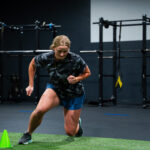Common Speed and Agility Training Mistakes to Avoid
Speed and agility training can take your athletic performance to the next level—but only if done correctly. Many athletes make avoidable mistakes that not only slow progress but can also increase the risk of injury.
In this article, we’ll go over the most common speed and agility training mistakes and how to avoid them. By fixing these issues, you’ll see better results, move faster, and train more effectively.
1. Skipping the Warm-Up
One of the biggest mistakes is jumping straight into drills without a proper warm-up. Cold muscles are less flexible and more prone to injury.
A good warm-up prepares your body for explosive movements. It increases your heart rate, activates your nervous system, and improves range of motion.
Fix: Spend at least 5–10 minutes warming up with dynamic stretches, mobility work, and light cardio. Include movements like high knees, lunges, butt kicks, and arm circles.
2. Poor Technique
Speed and agility training is all about efficiency. Using poor form—whether it’s leaning too far forward, overstriding, or letting your knees cave in—can slow you down and increase injury risk.
Good technique ensures that your movements are powerful, quick, and safe. Sloppy form often comes from rushing or fatigue.
Fix: Focus on quality over speed. Film your drills or work with a coach to correct mechanics. Keep your core tight, knees aligned, and body balanced during every drill.
3. Overtraining Without Recovery
Another common mistake is training too hard without allowing your body to recover. Speed and agility work is high intensity and demands a lot from your muscles and nervous system.
Without rest, you may experience fatigue, reduced performance, and even injury.
Fix: Schedule rest days and alternate hard sessions with light recovery workouts. Sleep, hydration, and nutrition also play vital roles in recovery. Don’t ignore the signs your body gives you.
4. Ignoring Strength Training
Some athletes focus only on drills and ignore strength development. But building strength—especially in the lower body and core—is essential for speed and agility.
Without a solid strength base, your drills won’t translate into real performance gains.
Fix: Combine speed and agility training with a strength program. Prioritize exercises like squats, lunges, deadlifts, and planks. Strength supports better movement mechanics and power output.
5. Using the Wrong Equipment
Using poor-quality or inappropriate equipment can limit your results. For example, an uneven agility ladder or overly stiff resistance bands can make drills frustrating or unsafe.
Sometimes athletes also misuse equipment, like overloading sleds or using unstable cones that slide.
Fix: Invest in high-quality, sport-specific gear. Make sure your agility ladder lies flat, cones stay in place, and bands provide the right resistance. For a full list, check out our guide to essential equipment.
6. Not Tracking Progress
Many athletes train without a plan or progress tracking. This makes it hard to know what’s working or when to make adjustments.
Without benchmarks, you risk stagnating or repeating ineffective drills.
Fix: Keep a simple training log. Track drill times, sets, reps, and how you feel. Over time, review your log and adjust your workouts. Celebrate progress and identify plateaus early.
7. Repeating the Same Drills
Doing the same drills over and over can cause performance plateaus and mental fatigue. Your body adapts quickly, so repeating identical drills too often may yield diminishing returns.
Variety keeps you mentally engaged and physically challenged.
Fix: Rotate your drills every few weeks. Introduce new patterns, vary direction, or change speed and intensity. You can also progress drills by adding resistance or reducing rest time.
8. Lack of Focus During Drills
Another issue is going through the motions without real intensity or purpose. Athletes often treat drills as a checklist instead of a performance opportunity.
Drills require mental focus to build coordination, reaction time, and movement quality.
Fix: Stay mentally engaged. Set a goal for each drill—like quicker foot speed or sharper turns. Take breaks if your focus drops. Quality beats quantity every time.
9. Neglecting Mobility and Flexibility
Tight hips, ankles, and hamstrings limit your ability to move efficiently. Many athletes overlook mobility, assuming it’s not as important as drills or lifting.
But without full range of motion, speed and agility suffer.
Fix: Incorporate mobility work into your routine. Stretch tight areas and use foam rollers to release tension. Improving flexibility helps you move more freely and lowers your injury risk.
10. Not Getting Professional Guidance
DIY programs can work to an extent, but without expert feedback, you might develop bad habits or miss key areas.
Having a coach can help you structure your program, correct your form, and push you appropriately.
Fix: Work with a certified trainer or join a program like the ones at Next Level Athletics. Expert eyes can accelerate your progress and keep you accountable.
Conclusion: Train Smarter, Not Just Harder
Speed and agility training is powerful—but only when done right. Avoiding these common mistakes ensures that your hard work pays off.
By focusing on technique, recovery, variety, and professional guidance, you’ll improve faster and reduce injury risk.
Want a smarter training plan tailored to your sport and goals? Visit Next Level Athletics and get started with expert help.
Also, for more tips on safe training habits, check out Healthline’s list of the risks of incorrect speed and agility training.


Recent Comments